window Seat Ibiza SC 2012 Service Manual
[x] Cancel search | Manufacturer: SEAT, Model Year: 2012, Model line: Ibiza SC, Model: Seat Ibiza SC 2012Pages: 280, PDF Size: 3.67 MB
Page 179 of 280
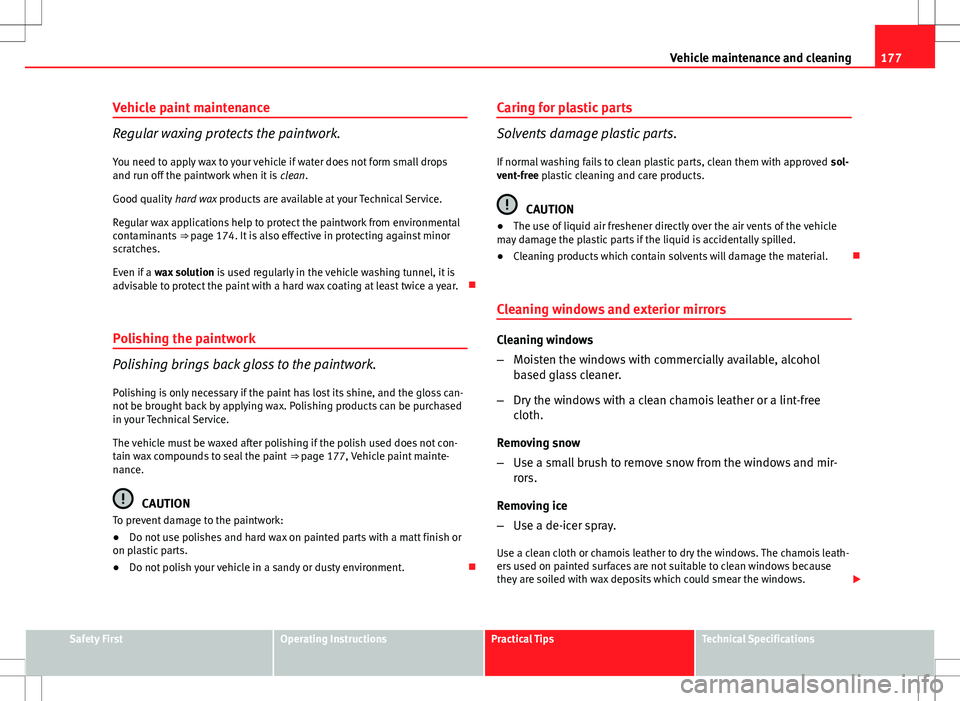
177
Vehicle maintenance and cleaning
Vehicle paint maintenance
Regular waxing protects the paintwork. You need to apply wax to your vehicle if water does not form small drops
and run off the paintwork when it is clean.
Good quality hard wax products are available at your Technical Service.
Regular wax applications help to protect the paintwork from environmental
contaminants ⇒ page 174. It is also effective in protecting against minor
scratches.
Even if a wax solution is used regularly in the vehicle washing tunnel, it is
advisable to protect the paint with a hard wax coating at least twice a year.
Polishing the paintwork
Polishing brings back gloss to the paintwork. Polishing is only necessary if the paint has lost its shine, and the gloss can-
not be brought back by applying wax. Polishing products can be purchased
in your Technical Service.
The vehicle must be waxed after polishing if the polish used does not con-
tain wax compounds to seal the paint ⇒ page 177, Vehicle paint mainte-
nance.
CAUTION
To prevent damage to the paintwork:
● Do not use polishes and hard wax on painted parts with a matt finish or
on plastic parts.
● Do not polish your vehicle in a sandy or dusty environment. Caring for plastic parts
Solvents damage plastic parts.
If normal washing fails to clean plastic parts, clean them with approved
sol-
vent-free plastic cleaning and care products.
CAUTION
● The use of liquid air freshener directly over the air vents of the vehicle
may damage the plastic parts if the liquid is accidentally spilled.
● Cleaning products which contain solvents will damage the material.
Cleaning windows and exterior mirrors
Cleaning windows
– Moisten the windows with commercially available, alcohol
based glass cleaner.
– Dry the windows with a clean chamois leather or a lint-free
cloth.
Removing snow
– Use a small brush to remove snow from the windows and mir-
rors.
Removing ice
– Use a de-icer spray.
Use a clean cloth or chamois leather to dry the windows. The chamois leath-
ers used on painted surfaces are not suitable to clean windows because
they are soiled with wax deposits which could smear the windows.
Safety FirstOperating InstructionsPractical TipsTechnical Specifications
Page 180 of 280
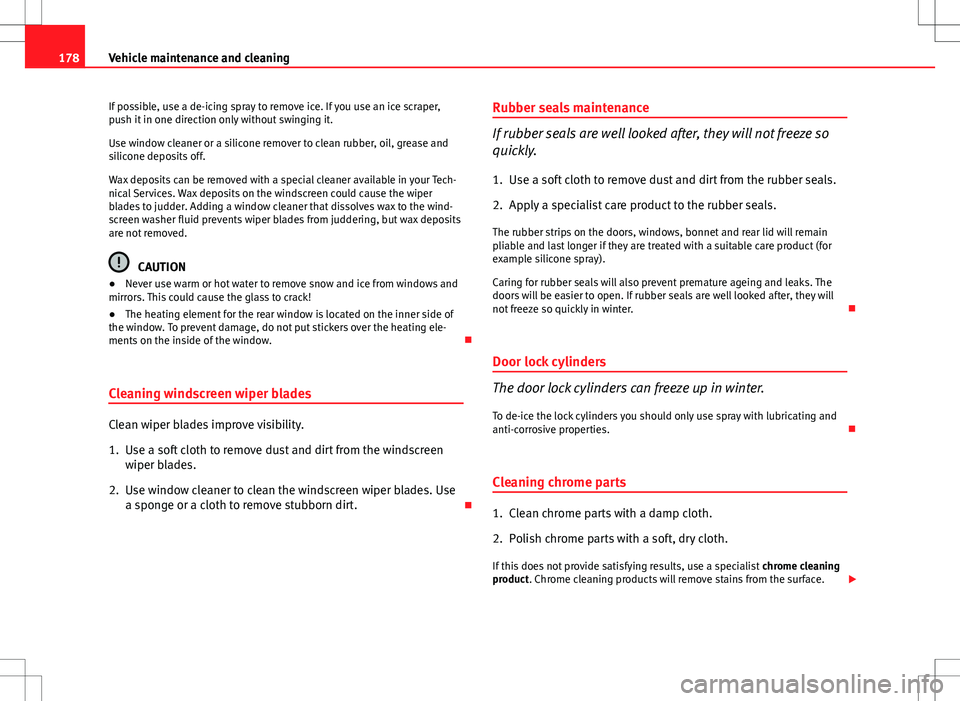
178Vehicle maintenance and cleaning
If possible, use a de-icing spray to remove ice. If you use an ice scraper,
push it in one direction only without swinging it.
Use window cleaner or a silicone remover to clean rubber, oil, grease and
silicone deposits off.
Wax deposits can be removed with a special cleaner available in your Tech-
nical Services. Wax deposits on the windscreen could cause the wiper
blades to judder. Adding a window cleaner that dissolves wax to the wind-
screen washer fluid prevents wiper blades from juddering, but wax deposits
are not removed.
CAUTION
● Never use warm or hot water to remove snow and ice from windows and
mirrors. This could cause the glass to crack!
● The heating element for the rear window is located on the inner side of
the window. To prevent damage, do not put stickers over the heating ele-
ments on the inside of the window.
Cleaning windscreen wiper blades
Clean wiper blades improve visibility.
1. Use a soft cloth to remove dust and dirt from the windscreen wiper blades.
2. Use window cleaner to clean the windscreen wiper blades. Use a sponge or a cloth to remove stubborn dirt. Rubber seals maintenance
If rubber seals are well looked after, they will not freeze so
quickly.
1. Use a soft cloth to remove dust and dirt from the rubber seals.
2. Apply a specialist care product to the rubber seals.
The rubber strips on the doors, windows, bonnet and rear lid will remain
pliable and last longer if they are treated with a suitable care product (for
example silicone spray).
Caring for rubber seals will also prevent premature ageing and leaks. The
doors will be easier to open. If rubber seals are well looked after, they will
not freeze so quickly in winter.
Door lock cylinders
The door lock cylinders can freeze up in winter.
To de-ice the lock cylinders you should only use spray with lubricating and
anti-corrosive properties.
Cleaning chrome parts
1. Clean chrome parts with a damp cloth.
2. Polish chrome parts with a soft, dry cloth. If this does not provide satisfying results, use a specialist chrome cleaning
product. Chrome cleaning products will remove stains from the surface.
Page 206 of 280
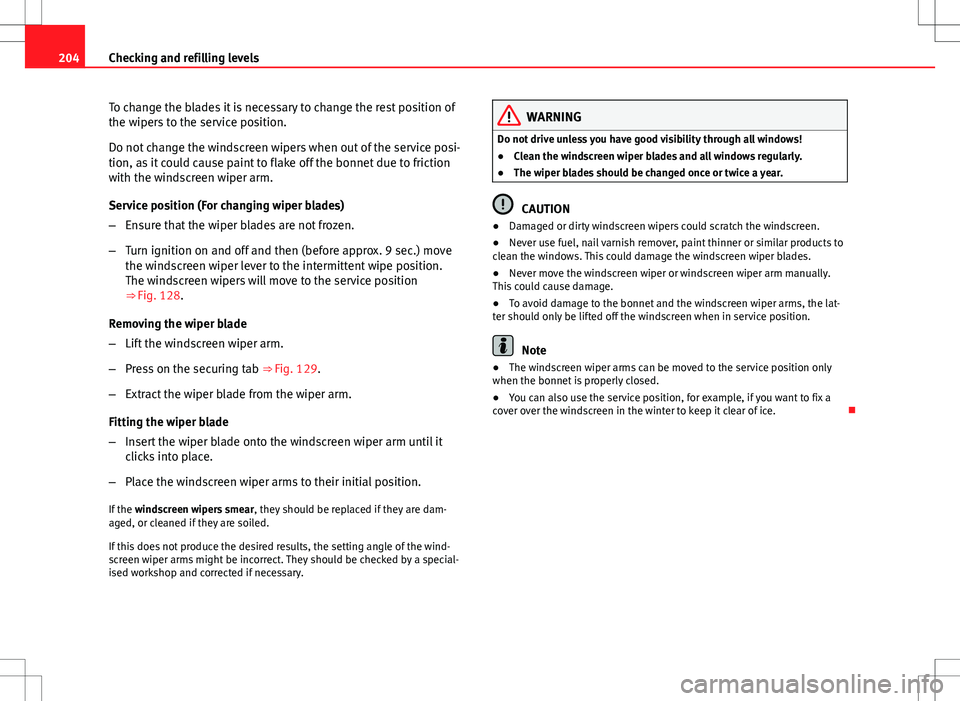
204Checking and refilling levels
To change the blades it is necessary to change the rest position of
the wipers to the service position.
Do not change the windscreen wipers when out of the service posi-
tion, as it could cause paint to flake off the bonnet due to friction
with the windscreen wiper arm.
Service position (For changing wiper blades)
–Ensure that the wiper blades are not frozen.
– Turn ignition on and off and then (before approx. 9 sec.) move
the windscreen wiper lever to the intermittent wipe position.
The windscreen wipers will move to the service position
⇒ Fig. 128.
Removing the wiper blade
– Lift the windscreen wiper arm.
– Press on the securing tab ⇒ Fig. 129.
– Extract the wiper blade from the wiper arm.
Fitting the wiper blade
– Insert the wiper blade onto the windscreen wiper arm until it
clicks into place.
– Place the windscreen wiper arms to their initial position.
If the windscreen wipers smear , they should be replaced if they are dam-
aged, or cleaned if they are soiled.
If this does not produce the desired results, the setting angle of the wind-
screen wiper arms might be incorrect. They should be checked by a special-
ised workshop and corrected if necessary.
WARNING
Do not drive unless you have good visibility through all windows!
● Clean the windscreen wiper blades and all windows regularly.
● The wiper blades should be changed once or twice a year.
CAUTION
● Damaged or dirty windscreen wipers could scratch the windscreen.
● Never use fuel, nail varnish remover, paint thinner or similar products to
clean the windows. This could damage the windscreen wiper blades.
● Never move the windscreen wiper or windscreen wiper arm manually.
This could cause damage.
● To avoid damage to the bonnet and the windscreen wiper arms, the lat-
ter should only be lifted off the windscreen when in service position.
Note
● The windscreen wiper arms can be moved to the service position only
when the bonnet is properly closed.
● You can also use the service position, for example, if you want to fix a
cover over the windscreen in the winter to keep it clear of ice.
Page 207 of 280
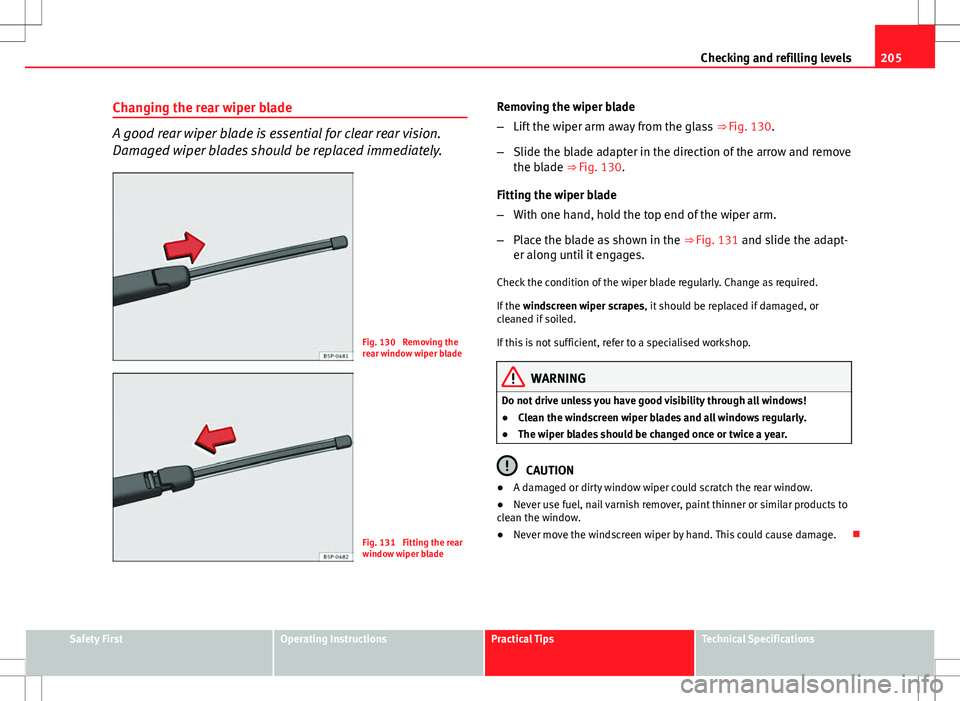
205
Checking and refilling levels
Changing the rear wiper blade
A good rear wiper blade is essential for clear rear vision.
Damaged wiper blades should be replaced immediately.
Fig. 130 Removing the
rear window wiper blade
Fig. 131 Fitting the rear
window wiper blade Removing the wiper blade
–
Lift the wiper arm away from the glass ⇒ Fig. 130.
– Slide the blade adapter in the direction of the arrow and remove
the blade ⇒ Fig. 130.
Fitting the wiper blade
– With one hand, hold the top end of the wiper arm.
– Place the blade as shown in the ⇒ Fig. 131 and slide the adapt-
er along until it engages.
Check the condition of the wiper blade regularly. Change as required.
If the windscreen wiper scrapes, it should be replaced if damaged, or
cleaned if soiled.
If this is not sufficient, refer to a specialised workshop.
WARNING
Do not drive unless you have good visibility through all windows!
● Clean the windscreen wiper blades and all windows regularly.
● The wiper blades should be changed once or twice a year.
CAUTION
● A damaged or dirty window wiper could scratch the rear window.
● Never use fuel, nail varnish remover, paint thinner or similar products to
clean the window.
● Never move the windscreen wiper by hand. This could cause damage.
Safety FirstOperating InstructionsPractical TipsTechnical Specifications
Page 210 of 280
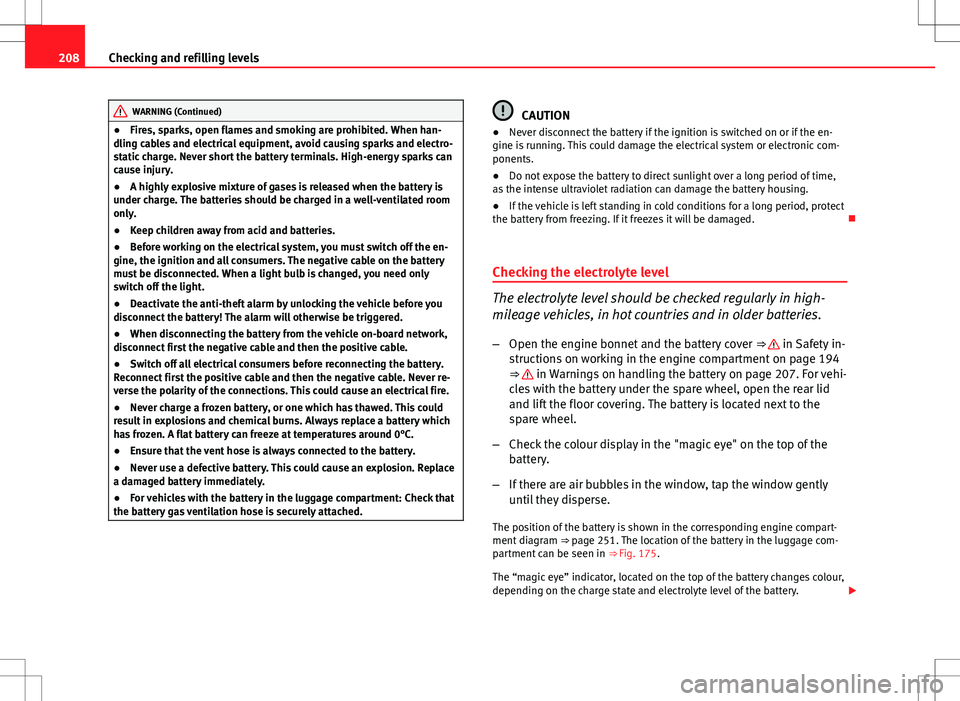
208Checking and refilling levels
WARNING (Continued)
● Fires, sparks, open flames and smoking are prohibited. When han-
dling cables and electrical equipment, avoid causing sparks and electro-
static charge. Never short the battery terminals. High-energy sparks can
cause injury.
● A highly explosive mixture of gases is released when the battery is
under charge. The batteries should be charged in a well-ventilated room
only.
● Keep children away from acid and batteries.
● Before working on the electrical system, you must switch off the en-
gine, the ignition and all consumers. The negative cable on the battery
must be disconnected. When a light bulb is changed, you need only
switch off the light.
● Deactivate the anti-theft alarm by unlocking the vehicle before you
disconnect the battery! The alarm will otherwise be triggered.
● When disconnecting the battery from the vehicle on-board network,
disconnect first the negative cable and then the positive cable.
● Switch off all electrical consumers before reconnecting the battery.
Reconnect first the positive cable and then the negative cable. Never re-
verse the polarity of the connections. This could cause an electrical fire.
● Never charge a frozen battery, or one which has thawed. This could
result in explosions and chemical burns. Always replace a battery which
has frozen. A flat battery can freeze at temperatures around 0°C.
● Ensure that the vent hose is always connected to the battery.
● Never use a defective battery. This could cause an explosion. Replace
a damaged battery immediately.
● For vehicles with the battery in the luggage compartment: Check that
the battery gas ventilation hose is securely attached.CAUTION
● Never disconnect the battery if the ignition is switched on or if the en-
gine is running. This could damage the electrical system or electronic com-
ponents.
● Do not expose the battery to direct sunlight over a long period of time,
as the intense ultraviolet radiation can damage the battery housing.
● If the vehicle is left standing in cold conditions for a long period, protect
the battery from freezing. If it freezes it will be damaged.
Checking the electrolyte level
The electrolyte level should be checked regularly in high-
mileage vehicles, in hot countries and in older batteries. – Open the engine bonnet and the battery cover ⇒
in Safety in-
structions on working in the engine compartment on page 194
⇒
in Warnings on handling the battery on page 207. For vehi-
cles with the battery under the spare wheel, open the rear lid
and lift the floor covering. The battery is located next to the
spare wheel.
– Check the colour display in the "magic eye" on the top of the
battery.
– If there are air bubbles in the window, tap the window gently
until they disperse.
The position of the battery is shown in the corresponding engine compart-
ment diagram ⇒ page 251. The location of the battery in the luggage com-
partment can be seen in ⇒ Fig. 175.
The “magic eye” indicator, located on the top of the battery changes colour,
depending on the charge state and electrolyte level of the battery.
Page 228 of 280
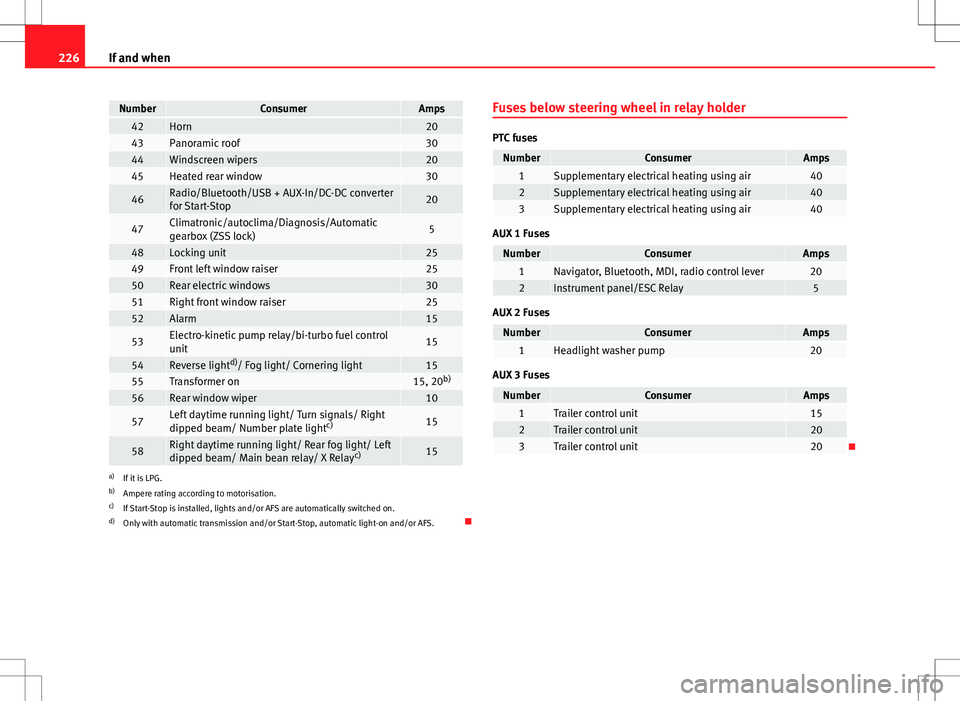
226If and when
NumberConsumerAmps42Horn2043Panoramic roof3044Windscreen wipers2045Heated rear window30
46Radio/Bluetooth/USB + AUX-In/DC-DC converter
for Start-Stop20
47Climatronic/autoclima/Diagnosis/Automatic
gearbox (ZSS lock)5
48Locking unit2549Front left window raiser2550Rear electric windows3051Right front window raiser2552Alarm15
53Electro-kinetic pump relay/bi-turbo fuel control
unit15
54Reverse light d)
/ Fog light/ Cornering light1555Transformer on15, 20 b)56Rear window wiper10
57Left daytime running light/ Turn signals/ Right
dipped beam/ Number plate light c)15
58Right daytime running light/ Rear fog light/ Left
dipped beam/ Main bean relay/ X Relay c)15
a)
If it is LPG.
b) Ampere rating according to motorisation.
c) If Start-Stop is installed, lights and/or AFS are automatically switched on.
d) Only with automatic transmission and/or Start-Stop, automatic light-on and/or AFS. Fuses below steering wheel in relay holder
PTC fuses
NumberConsumerAmps1Supplementary electrical heating using air402Supplementary electrical heating using air403Supplementary electrical heating using air40
AUX 1 Fuses
NumberConsumerAmps1Navigator, Bluetooth, MDI, radio control lever202Instrument panel/ESC Relay5
AUX 2 Fuses
NumberConsumerAmps1Headlight washer pump20
AUX 3 Fuses
NumberConsumerAmps1Trailer control unit152Trailer control unit203Trailer control unit20
Page 245 of 280
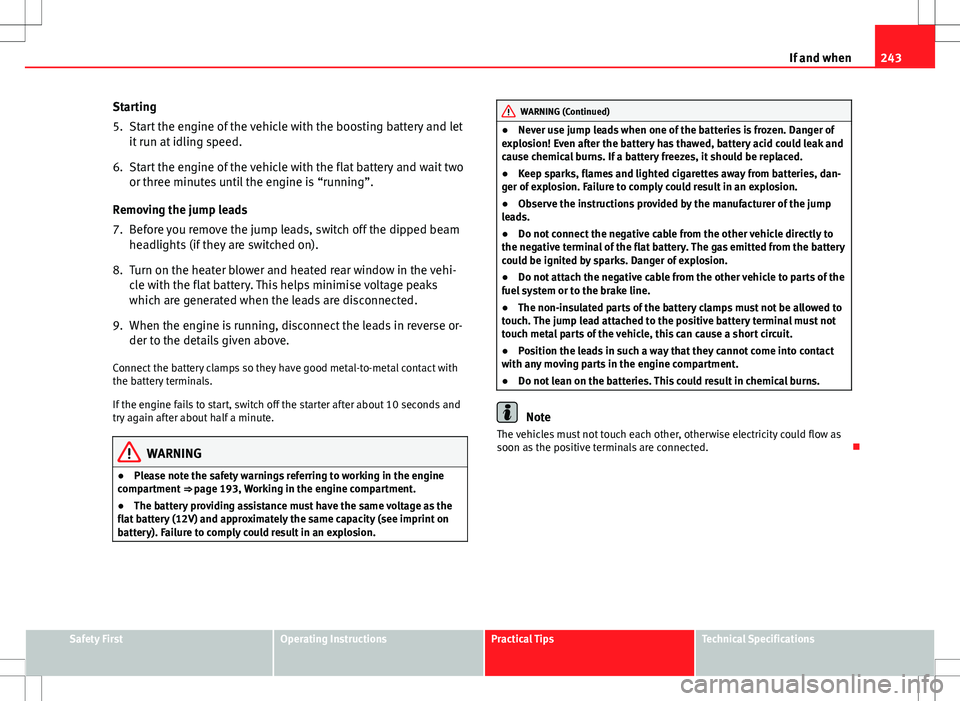
243
If and when
Starting
5. Start the engine of the vehicle with the boosting battery and let it run at idling speed.
6. Start the engine of the vehicle with the flat battery and wait two or three minutes until the engine is “running”.
Removing the jump leads
7. Before you remove the jump leads, switch off the dipped beam headlights (if they are switched on).
8. Turn on the heater blower and heated rear window in the vehi- cle with the flat battery. This helps minimise voltage peaks
which are generated when the leads are disconnected.
9. When the engine is running, disconnect the leads in reverse or- der to the details given above.
Connect the battery clamps so they have good metal-to-metal contact with
the battery terminals.
If the engine fails to start, switch off the starter after about 10 seconds and
try again after about half a minute.
WARNING
● Please note the safety warnings referring to working in the engine
compartment ⇒ page 193, Working in the engine compartment.
● The battery providing assistance must have the same voltage as the
flat battery (12V) and approximately the same capacity (see imprint on
battery). Failure to comply could result in an explosion.
WARNING (Continued)
● Never use jump leads when one of the batteries is frozen. Danger of
explosion! Even after the battery has thawed, battery acid could leak and
cause chemical burns. If a battery freezes, it should be replaced.
● Keep sparks, flames and lighted cigarettes away from batteries, dan-
ger of explosion. Failure to comply could result in an explosion.
● Observe the instructions provided by the manufacturer of the jump
leads.
● Do not connect the negative cable from the other vehicle directly to
the negative terminal of the flat battery. The gas emitted from the battery
could be ignited by sparks. Danger of explosion.
● Do not attach the negative cable from the other vehicle to parts of the
fuel system or to the brake line.
● The non-insulated parts of the battery clamps must not be allowed to
touch. The jump lead attached to the positive battery terminal must not
touch metal parts of the vehicle, this can cause a short circuit.
● Position the leads in such a way that they cannot come into contact
with any moving parts in the engine compartment.
● Do not lean on the batteries. This could result in chemical burns.
Note
The vehicles must not touch each other, otherwise electricity could flow as
soon as the positive terminals are connected.
Safety FirstOperating InstructionsPractical TipsTechnical Specifications
Page 272 of 280
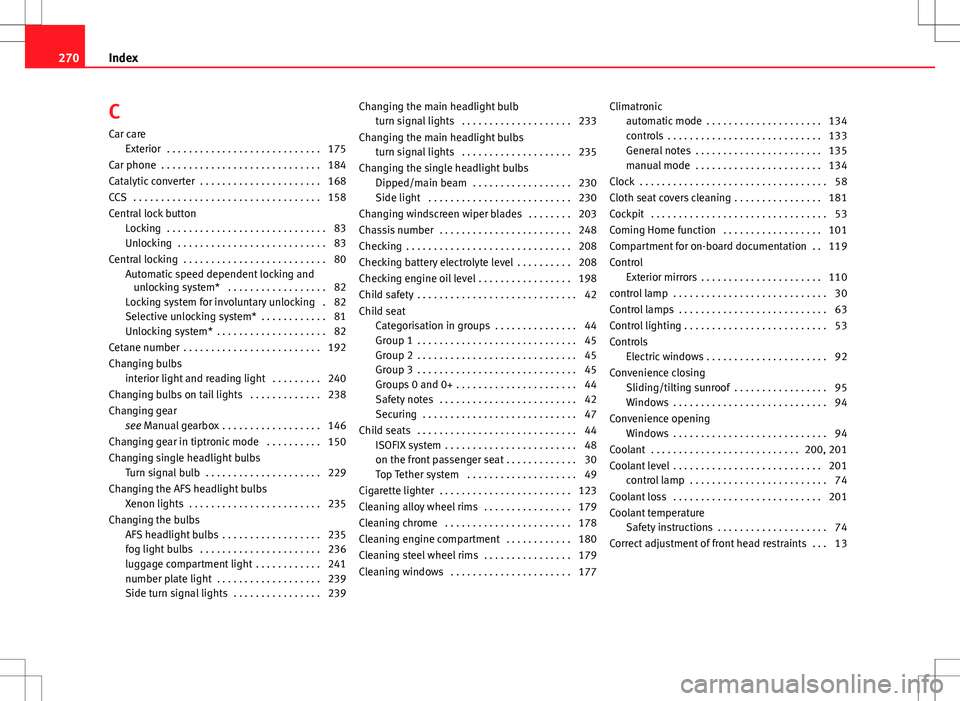
C
Car care Exterior . . . . . . . . . . . . . . . . . . . . . . . . . . . . 175
Car phone . . . . . . . . . . . . . . . . . . . . . . . . . . . . . 184
Catalytic converter . . . . . . . . . . . . . . . . . . . . . . 168
CCS . . . . . . . . . . . . . . . . . . . . . . . . . . . . . . . . . . 158
Central lock button Locking . . . . . . . . . . . . . . . . . . . . . . . . . . . . . 83
Unlocking . . . . . . . . . . . . . . . . . . . . . . . . . . . 83
Central locking . . . . . . . . . . . . . . . . . . . . . . . . . . 80 Automatic speed dependent locking andunlocking system* . . . . . . . . . . . . . . . . . . 82
Locking system for involuntary unlocking . 82
Selective unlocking system* . . . . . . . . . . . . 81
Unlocking system* . . . . . . . . . . . . . . . . . . . . 82
Cetane number . . . . . . . . . . . . . . . . . . . . . . . . . 192
Changing bulbs interior light and reading light . . . . . . . . . 240
Changing bulbs on tail lights . . . . . . . . . . . . . 238
Changing gear see Manual gearbox . . . . . . . . . . . . . . . . . . 146
Changing gear in tiptronic mode . . . . . . . . . . 150
Changing single headlight bulbs Turn signal bulb . . . . . . . . . . . . . . . . . . . . . 229
Changing the AFS headlight bulbs Xenon lights . . . . . . . . . . . . . . . . . . . . . . . . 235
Changing the bulbs AFS headlight bulbs . . . . . . . . . . . . . . . . . . 235
fog light bulbs . . . . . . . . . . . . . . . . . . . . . . 236
luggage compartment light . . . . . . . . . . . . 241
number plate light . . . . . . . . . . . . . . . . . . . 239
Side turn signal lights . . . . . . . . . . . . . . . . 239 Changing the main headlight bulb
turn signal lights . . . . . . . . . . . . . . . . . . . . 233
Changing the main headlight bulbs turn signal lights . . . . . . . . . . . . . . . . . . . . 235
Changing the single headlight bulbs Dipped/main beam . . . . . . . . . . . . . . . . . . 230
Side light . . . . . . . . . . . . . . . . . . . . . . . . . . 230
Changing windscreen wiper blades . . . . . . . . 203
Chassis number . . . . . . . . . . . . . . . . . . . . . . . . 248
Checking . . . . . . . . . . . . . . . . . . . . . . . . . . . . . . 208
Checking battery electrolyte level . . . . . . . . . . 208
Checking engine oil level . . . . . . . . . . . . . . . . . 198
Child safety . . . . . . . . . . . . . . . . . . . . . . . . . . . . . 42
Child seat Categorisation in groups . . . . . . . . . . . . . . . 44
Group 1 . . . . . . . . . . . . . . . . . . . . . . . . . . . . . 45
Group 2 . . . . . . . . . . . . . . . . . . . . . . . . . . . . . 45
Group 3 . . . . . . . . . . . . . . . . . . . . . . . . . . . . . 45
Groups 0 and 0+ . . . . . . . . . . . . . . . . . . . . . . 44
Safety notes . . . . . . . . . . . . . . . . . . . . . . . . . 42
Securing . . . . . . . . . . . . . . . . . . . . . . . . . . . . 47
Child seats . . . . . . . . . . . . . . . . . . . . . . . . . . . . . 44 ISOFIX system . . . . . . . . . . . . . . . . . . . . . . . . 48
on the front passenger seat . . . . . . . . . . . . . 30
Top Tether system . . . . . . . . . . . . . . . . . . . . 49
Cigarette lighter . . . . . . . . . . . . . . . . . . . . . . . . 123
Cleaning alloy wheel rims . . . . . . . . . . . . . . . . 179
Cleaning chrome . . . . . . . . . . . . . . . . . . . . . . . 178
Cleaning engine compartment . . . . . . . . . . . . 180
Cleaning steel wheel rims . . . . . . . . . . . . . . . . 179
Cleaning windows . . . . . . . . . . . . . . . . . . . . . . 177 Climatronic
automatic mode . . . . . . . . . . . . . . . . . . . . . 134
controls . . . . . . . . . . . . . . . . . . . . . . . . . . . . 133
General notes . . . . . . . . . . . . . . . . . . . . . . . 135
manual mode . . . . . . . . . . . . . . . . . . . . . . . 134
Clock . . . . . . . . . . . . . . . . . . . . . . . . . . . . . . . . . . 58
Cloth seat covers cleaning . . . . . . . . . . . . . . . . 181
Cockpit . . . . . . . . . . . . . . . . . . . . . . . . . . . . . . . . 53
Coming Home function . . . . . . . . . . . . . . . . . . 101
Compartment for on-board documentation . . 119
Control Exterior mirrors . . . . . . . . . . . . . . . . . . . . . . 110
control lamp . . . . . . . . . . . . . . . . . . . . . . . . . . . . 30
Control lamps . . . . . . . . . . . . . . . . . . . . . . . . . . . 63
Control lighting . . . . . . . . . . . . . . . . . . . . . . . . . . 53
Controls Electric windows . . . . . . . . . . . . . . . . . . . . . . 92
Convenience closing Sliding/tilting sunroof . . . . . . . . . . . . . . . . . 95
Windows . . . . . . . . . . . . . . . . . . . . . . . . . . . . 94
Convenience opening Windows . . . . . . . . . . . . . . . . . . . . . . . . . . . . 94
Coolant . . . . . . . . . . . . . . . . . . . . . . . . . . . 200, 201
Coolant level . . . . . . . . . . . . . . . . . . . . . . . . . . . 201 control lamp . . . . . . . . . . . . . . . . . . . . . . . . . 74
Coolant loss . . . . . . . . . . . . . . . . . . . . . . . . . . . 201
Coolant temperature Safety instructions . . . . . . . . . . . . . . . . . . . . 74
Correct adjustment of front head restraints . . . 13
270 Index
Page 274 of 280
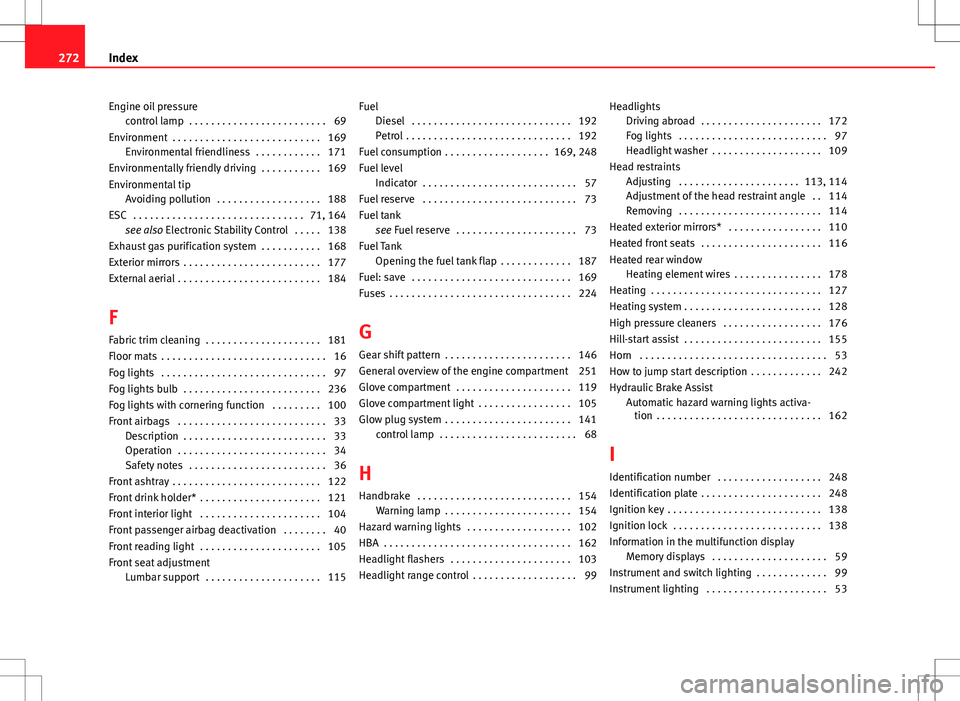
Engine oil pressurecontrol lamp . . . . . . . . . . . . . . . . . . . . . . . . . 69
Environment . . . . . . . . . . . . . . . . . . . . . . . . . . . 169 Environmental friendliness . . . . . . . . . . . . 171
Environmentally friendly driving . . . . . . . . . . . 169
Environmental tip Avoiding pollution . . . . . . . . . . . . . . . . . . . 188
ESC . . . . . . . . . . . . . . . . . . . . . . . . . . . . . . . 71, 164 see also Electronic Stability Control . . . . . 138
Exhaust gas purification system . . . . . . . . . . . 168
Exterior mirrors . . . . . . . . . . . . . . . . . . . . . . . . . 177
External aerial . . . . . . . . . . . . . . . . . . . . . . . . . . 184
F
Fabric trim cleaning . . . . . . . . . . . . . . . . . . . . . 181
Floor mats . . . . . . . . . . . . . . . . . . . . . . . . . . . . . . 16
Fog lights . . . . . . . . . . . . . . . . . . . . . . . . . . . . . . 97
Fog lights bulb . . . . . . . . . . . . . . . . . . . . . . . . . 236
Fog lights with cornering function . . . . . . . . . 100
Front airbags . . . . . . . . . . . . . . . . . . . . . . . . . . . 33 Description . . . . . . . . . . . . . . . . . . . . . . . . . . 33
Operation . . . . . . . . . . . . . . . . . . . . . . . . . . . 34
Safety notes . . . . . . . . . . . . . . . . . . . . . . . . . 36
Front ashtray . . . . . . . . . . . . . . . . . . . . . . . . . . . 122
Front drink holder* . . . . . . . . . . . . . . . . . . . . . . 121
Front interior light . . . . . . . . . . . . . . . . . . . . . . 104
Front passenger airbag deactivation . . . . . . . . 40
Front reading light . . . . . . . . . . . . . . . . . . . . . . 105
Front seat adjustment Lumbar support . . . . . . . . . . . . . . . . . . . . . 115 Fuel
Diesel . . . . . . . . . . . . . . . . . . . . . . . . . . . . . 192
Petrol . . . . . . . . . . . . . . . . . . . . . . . . . . . . . . 192
Fuel consumption . . . . . . . . . . . . . . . . . . . 169, 248
Fuel level Indicator . . . . . . . . . . . . . . . . . . . . . . . . . . . . 57
Fuel reserve . . . . . . . . . . . . . . . . . . . . . . . . . . . . 73
Fuel tank see Fuel reserve . . . . . . . . . . . . . . . . . . . . . . 73
Fuel Tank Opening the fuel tank flap . . . . . . . . . . . . . 187
Fuel: save . . . . . . . . . . . . . . . . . . . . . . . . . . . . . 169
Fuses . . . . . . . . . . . . . . . . . . . . . . . . . . . . . . . . . 224
G
Gear shift pattern . . . . . . . . . . . . . . . . . . . . . . . 146
General overview of the engine compartment 251
Glove compartment . . . . . . . . . . . . . . . . . . . . . 119
Glove compartment light . . . . . . . . . . . . . . . . . 105
Glow plug system . . . . . . . . . . . . . . . . . . . . . . . 141 control lamp . . . . . . . . . . . . . . . . . . . . . . . . . 68
H
Handbrake . . . . . . . . . . . . . . . . . . . . . . . . . . . . 154 Warning lamp . . . . . . . . . . . . . . . . . . . . . . . 154
Hazard warning lights . . . . . . . . . . . . . . . . . . . 102
HBA . . . . . . . . . . . . . . . . . . . . . . . . . . . . . . . . . . 162
Headlight flashers . . . . . . . . . . . . . . . . . . . . . . 103
Headlight range control . . . . . . . . . . . . . . . . . . . 99 Headlights
Driving abroad . . . . . . . . . . . . . . . . . . . . . . 172
Fog lights . . . . . . . . . . . . . . . . . . . . . . . . . . . 97
Headlight washer . . . . . . . . . . . . . . . . . . . . 109
Head restraints Adjusting . . . . . . . . . . . . . . . . . . . . . . 113, 114
Adjustment of the head restraint angle . . 114
Removing . . . . . . . . . . . . . . . . . . . . . . . . . . 114
Heated exterior mirrors* . . . . . . . . . . . . . . . . . 110
Heated front seats . . . . . . . . . . . . . . . . . . . . . . 116
Heated rear window Heating element wires . . . . . . . . . . . . . . . . 178
Heating . . . . . . . . . . . . . . . . . . . . . . . . . . . . . . . 127
Heating system . . . . . . . . . . . . . . . . . . . . . . . . . 128
High pressure cleaners . . . . . . . . . . . . . . . . . . 176
Hill-start assist . . . . . . . . . . . . . . . . . . . . . . . . . 155
Horn . . . . . . . . . . . . . . . . . . . . . . . . . . . . . . . . . . 53
How to jump start description . . . . . . . . . . . . . 242
Hydraulic Brake Assist Automatic hazard warning lights activa-tion . . . . . . . . . . . . . . . . . . . . . . . . . . . . . . 162
I
Identification number . . . . . . . . . . . . . . . . . . . 248
Identification plate . . . . . . . . . . . . . . . . . . . . . . 248
Ignition key . . . . . . . . . . . . . . . . . . . . . . . . . . . . 138
Ignition lock . . . . . . . . . . . . . . . . . . . . . . . . . . . 138
Information in the multifunction display Memory displays . . . . . . . . . . . . . . . . . . . . . 59
Instrument and switch lighting . . . . . . . . . . . . . 99
Instrument lighting . . . . . . . . . . . . . . . . . . . . . . 53
272 Index
Page 275 of 280
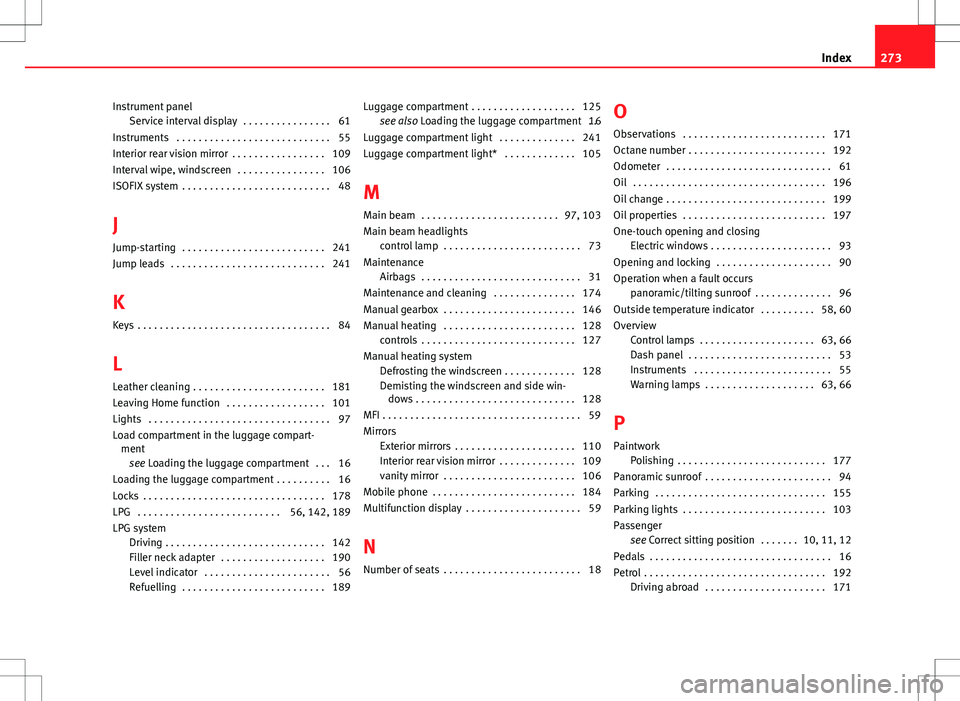
Instrument panelService interval display . . . . . . . . . . . . . . . . 61
Instruments . . . . . . . . . . . . . . . . . . . . . . . . . . . . 55
Interior rear vision mirror . . . . . . . . . . . . . . . . . 109
Interval wipe, windscreen . . . . . . . . . . . . . . . . 106
ISOFIX system . . . . . . . . . . . . . . . . . . . . . . . . . . . 48
J
Jump-starting . . . . . . . . . . . . . . . . . . . . . . . . . . 241
Jump leads . . . . . . . . . . . . . . . . . . . . . . . . . . . . 241
K
Keys . . . . . . . . . . . . . . . . . . . . . . . . . . . . . . . . . . . 84
L Leather cleaning . . . . . . . . . . . . . . . . . . . . . . . . 181
Leaving Home function . . . . . . . . . . . . . . . . . . 101
Lights . . . . . . . . . . . . . . . . . . . . . . . . . . . . . . . . . 97
Load compartment in the luggage compart- ment
see Loading the luggage compartment . . . 16
Loading the luggage compartment . . . . . . . . . . 16
Locks . . . . . . . . . . . . . . . . . . . . . . . . . . . . . . . . . 178
LPG . . . . . . . . . . . . . . . . . . . . . . . . . . 56, 142, 189
LPG system Driving . . . . . . . . . . . . . . . . . . . . . . . . . . . . . 142
Filler neck adapter . . . . . . . . . . . . . . . . . . . 190
Level indicator . . . . . . . . . . . . . . . . . . . . . . . 56
Refuelling . . . . . . . . . . . . . . . . . . . . . . . . . . 189 Luggage compartment . . . . . . . . . . . . . . . . . . . 125
see also Loading the luggage compartment . .16
Luggage compartment light . . . . . . . . . . . . . . 241
Luggage compartment light* . . . . . . . . . . . . . 105
M
Main beam . . . . . . . . . . . . . . . . . . . . . . . . . 97, 103
Main beam headlights control lamp . . . . . . . . . . . . . . . . . . . . . . . . . 73
Maintenance Airbags . . . . . . . . . . . . . . . . . . . . . . . . . . . . . 31
Maintenance and cleaning . . . . . . . . . . . . . . . 174
Manual gearbox . . . . . . . . . . . . . . . . . . . . . . . . 146
Manual heating . . . . . . . . . . . . . . . . . . . . . . . . 128 controls . . . . . . . . . . . . . . . . . . . . . . . . . . . . 127
Manual heating system Defrosting the windscreen . . . . . . . . . . . . . 128
Demisting the windscreen and side win-dows . . . . . . . . . . . . . . . . . . . . . . . . . . . . . 128
MFI . . . . . . . . . . . . . . . . . . . . . . . . . . . . . . . . . . . . 59
Mirrors Exterior mirrors . . . . . . . . . . . . . . . . . . . . . . 110
Interior rear vision mirror . . . . . . . . . . . . . . 109
vanity mirror . . . . . . . . . . . . . . . . . . . . . . . . 106
Mobile phone . . . . . . . . . . . . . . . . . . . . . . . . . . 184
Multifunction display . . . . . . . . . . . . . . . . . . . . . 59
N
Number of seats . . . . . . . . . . . . . . . . . . . . . . . . . 18 O
Observations . . . . . . . . . . . . . . . . . . . . . . . . . . 171
Octane number . . . . . . . . . . . . . . . . . . . . . . . . . 192
Odometer . . . . . . . . . . . . . . . . . . . . . . . . . . . . . . 61
Oil . . . . . . . . . . . . . . . . . . . . . . . . . . . . . . . . . . . 196
Oil change . . . . . . . . . . . . . . . . . . . . . . . . . . . . . 199
Oil properties . . . . . . . . . . . . . . . . . . . . . . . . . . 197
One-touch opening and closing Electric windows . . . . . . . . . . . . . . . . . . . . . . 93
Opening and locking . . . . . . . . . . . . . . . . . . . . . 90
Operation when a fault occurs panoramic/tilting sunroof . . . . . . . . . . . . . . 96
Outside temperature indicator . . . . . . . . . . 58, 60
Overview Control lamps . . . . . . . . . . . . . . . . . . . . . 63, 66
Dash panel . . . . . . . . . . . . . . . . . . . . . . . . . . 53
Instruments . . . . . . . . . . . . . . . . . . . . . . . . . 55
Warning lamps . . . . . . . . . . . . . . . . . . . . 63, 66
P
Paintwork Polishing . . . . . . . . . . . . . . . . . . . . . . . . . . . 177
Panoramic sunroof . . . . . . . . . . . . . . . . . . . . . . . 94
Parking . . . . . . . . . . . . . . . . . . . . . . . . . . . . . . . 155
Parking lights . . . . . . . . . . . . . . . . . . . . . . . . . . 103
Passenger see Correct sitting position . . . . . . . 10, 11, 12
Pedals . . . . . . . . . . . . . . . . . . . . . . . . . . . . . . . . . 16
Petrol . . . . . . . . . . . . . . . . . . . . . . . . . . . . . . . . . 192 Driving abroad . . . . . . . . . . . . . . . . . . . . . . 171
273
Index